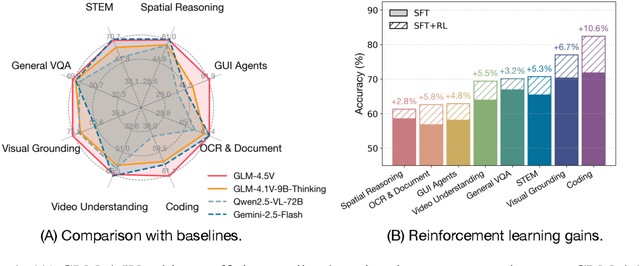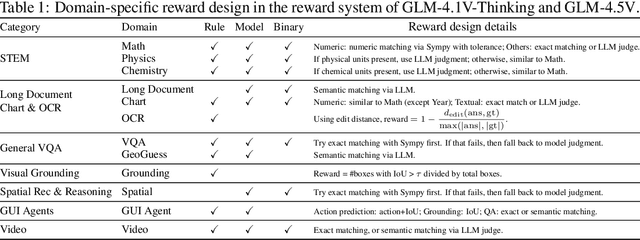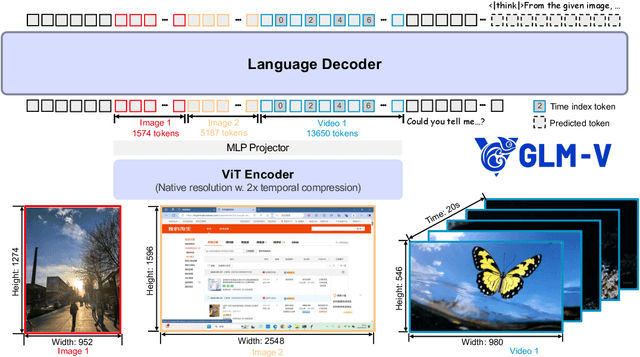Minlie Huang
EJ
Trust-Region Adaptive Policy Optimization
Dec 19, 2025Abstract:Post-training methods, especially Supervised Fine-Tuning (SFT) and Reinforcement Learning (RL), play an important role in improving large language models' (LLMs) complex reasoning abilities. However, the dominant two-stage pipeline (SFT then RL) suffers from a key inconsistency: SFT enforces rigid imitation that suppresses exploration and induces forgetting, limiting RL's potential for improvements. We address this inefficiency with TRAPO (\textbf{T}rust-\textbf{R}egion \textbf{A}daptive \textbf{P}olicy \textbf{O}ptimization), a hybrid framework that interleaves SFT and RL within each training instance by optimizing SFT loss on expert prefixes and RL loss on the model's own completions, unifying external supervision and self-exploration. To stabilize training, we introduce Trust-Region SFT (TrSFT), which minimizes forward KL divergence inside a trust region but attenuates optimization outside, effectively shifting toward reverse KL and yielding stable, mode-seeking updates favorable for RL. An adaptive prefix-selection mechanism further allocates expert guidance based on measured utility. Experiments on five mathematical reasoning benchmarks show that TRAPO consistently surpasses standard SFT, RL, and SFT-then-RL pipelines, as well as recent state-of-the-art approaches, establishing a strong new paradigm for reasoning-enhanced LLMs.
DPRM: A Dual Implicit Process Reward Model in Multi-Hop Question Answering
Nov 11, 2025Abstract:In multi-hop question answering (MHQA) tasks, Chain of Thought (CoT) improves the quality of generation by guiding large language models (LLMs) through multi-step reasoning, and Knowledge Graphs (KGs) reduce hallucinations via semantic matching. Outcome Reward Models (ORMs) provide feedback after generating the final answers but fail to evaluate the process for multi-step reasoning. Traditional Process Reward Models (PRMs) evaluate the reasoning process but require costly human annotations or rollout generation. While implicit PRM is trained only with outcome signals and derives step rewards through reward parameterization without explicit annotations, it is more suitable for multi-step reasoning in MHQA tasks. However, existing implicit PRM has only been explored for plain text scenarios. When adapting to MHQA tasks, it cannot handle the graph structure constraints in KGs and capture the potential inconsistency between CoT and KG paths. To address these limitations, we propose the DPRM (Dual Implicit Process Reward Model). It trains two implicit PRMs for CoT and KG reasoning in MHQA tasks. Both PRMs, namely KG-PRM and CoT-PRM, derive step-level rewards from outcome signals via reward parameterization without additional explicit annotations. Among them, KG-PRM uses preference pairs to learn structural constraints from KGs. DPRM further introduces a consistency constraint between CoT and KG reasoning steps, making the two PRMs mutually verify and collaboratively optimize the reasoning paths. We also provide a theoretical demonstration of the derivation of process rewards. Experimental results show that our method outperforms 13 baselines on multiple datasets with up to 16.6% improvement on Hit@1.
Data-Efficient RLVR via Off-Policy Influence Guidance
Oct 30, 2025Abstract:Data selection is a critical aspect of Reinforcement Learning with Verifiable Rewards (RLVR) for enhancing the reasoning capabilities of large language models (LLMs). Current data selection methods are largely heuristic-based, lacking theoretical guarantees and generalizability. This work proposes a theoretically-grounded approach using influence functions to estimate the contribution of each data point to the learning objective. To overcome the prohibitive computational cost of policy rollouts required for online influence estimation, we introduce an off-policy influence estimation method that efficiently approximates data influence using pre-collected offline trajectories. Furthermore, to manage the high-dimensional gradients of LLMs, we employ sparse random projection to reduce dimensionality and improve storage and computation efficiency. Leveraging these techniques, we develop \textbf{C}urriculum \textbf{R}L with \textbf{O}ff-\textbf{P}olicy \text{I}nfluence guidance (\textbf{CROPI}), a multi-stage RL framework that iteratively selects the most influential data for the current policy. Experiments on models up to 7B parameters demonstrate that CROPI significantly accelerates training. On a 1.5B model, it achieves a 2.66x step-level acceleration while using only 10\% of the data per stage compared to full-dataset training. Our results highlight the substantial potential of influence-based data selection for efficient RLVR.
Think Socially via Cognitive Reasoning
Sep 26, 2025Abstract:LLMs trained for logical reasoning excel at step-by-step deduction to reach verifiable answers. However, this paradigm is ill-suited for navigating social situations, which induce an interpretive process of analyzing ambiguous cues that rarely yield a definitive outcome. To bridge this gap, we introduce Cognitive Reasoning, a paradigm modeled on human social cognition. It formulates the interpretive process into a structured cognitive flow of interconnected cognitive units (e.g., observation or attribution), which combine adaptively to enable effective social thinking and responses. We then propose CogFlow, a complete framework that instills this capability in LLMs. CogFlow first curates a dataset of cognitive flows by simulating the associative and progressive nature of human thought via tree-structured planning. After instilling the basic cognitive reasoning capability via supervised fine-tuning, CogFlow adopts reinforcement learning to enable the model to improve itself via trial and error, guided by a multi-objective reward that optimizes both cognitive flow and response quality. Extensive experiments show that CogFlow effectively enhances the social cognitive capabilities of LLMs, and even humans, leading to more effective social decision-making.
Speculating LLMs' Chinese Training Data Pollution from Their Tokens
Aug 25, 2025



Abstract:Tokens are basic elements in the datasets for LLM training. It is well-known that many tokens representing Chinese phrases in the vocabulary of GPT (4o/4o-mini/o1/o3/4.5/4.1/o4-mini) are indicating contents like pornography or online gambling. Based on this observation, our goal is to locate Polluted Chinese (PoC) tokens in LLMs and study the relationship between PoC tokens' existence and training data. (1) We give a formal definition and taxonomy of PoC tokens based on the GPT's vocabulary. (2) We build a PoC token detector via fine-tuning an LLM to label PoC tokens in vocabularies by considering each token's both semantics and related contents from the search engines. (3) We study the speculation on the training data pollution via PoC tokens' appearances (token ID). Experiments on GPT and other 23 LLMs indicate that tokens widely exist while GPT's vocabulary behaves the worst: more than 23% long Chinese tokens (i.e., a token with more than two Chinese characters) are either porn or online gambling. We validate the accuracy of our speculation method on famous pre-training datasets like C4 and Pile. Then, considering GPT-4o, we speculate that the ratio of "Yui Hatano" related webpages in GPT-4o's training data is around 0.5%.
GLM-4.5: Agentic, Reasoning, and Coding (ARC) Foundation Models
Aug 08, 2025Abstract:We present GLM-4.5, an open-source Mixture-of-Experts (MoE) large language model with 355B total parameters and 32B activated parameters, featuring a hybrid reasoning method that supports both thinking and direct response modes. Through multi-stage training on 23T tokens and comprehensive post-training with expert model iteration and reinforcement learning, GLM-4.5 achieves strong performance across agentic, reasoning, and coding (ARC) tasks, scoring 70.1% on TAU-Bench, 91.0% on AIME 24, and 64.2% on SWE-bench Verified. With much fewer parameters than several competitors, GLM-4.5 ranks 3rd overall among all evaluated models and 2nd on agentic benchmarks. We release both GLM-4.5 (355B parameters) and a compact version, GLM-4.5-Air (106B parameters), to advance research in reasoning and agentic AI systems. Code, models, and more information are available at https://github.com/zai-org/GLM-4.5.
JPS: Jailbreak Multimodal Large Language Models with Collaborative Visual Perturbation and Textual Steering
Aug 07, 2025Abstract:Jailbreak attacks against multimodal large language Models (MLLMs) are a significant research focus. Current research predominantly focuses on maximizing attack success rate (ASR), often overlooking whether the generated responses actually fulfill the attacker's malicious intent. This oversight frequently leads to low-quality outputs that bypass safety filters but lack substantial harmful content. To address this gap, we propose JPS, \underline{J}ailbreak MLLMs with collaborative visual \underline{P}erturbation and textual \underline{S}teering, which achieves jailbreaks via corporation of visual image and textually steering prompt. Specifically, JPS utilizes target-guided adversarial image perturbations for effective safety bypass, complemented by "steering prompt" optimized via a multi-agent system to specifically guide LLM responses fulfilling the attackers' intent. These visual and textual components undergo iterative co-optimization for enhanced performance. To evaluate the quality of attack outcomes, we propose the Malicious Intent Fulfillment Rate (MIFR) metric, assessed using a Reasoning-LLM-based evaluator. Our experiments show JPS sets a new state-of-the-art in both ASR and MIFR across various MLLMs and benchmarks, with analyses confirming its efficacy. Codes are available at \href{https://github.com/thu-coai/JPS}{https://github.com/thu-coai/JPS}. \color{warningcolor}{Warning: This paper contains potentially sensitive contents.}
Unveiling the Landscape of Clinical Depression Assessment: From Behavioral Signatures to Psychiatric Reasoning
Aug 06, 2025Abstract:Depression is a widespread mental disorder that affects millions worldwide. While automated depression assessment shows promise, most studies rely on limited or non-clinically validated data, and often prioritize complex model design over real-world effectiveness. In this paper, we aim to unveil the landscape of clinical depression assessment. We introduce C-MIND, a clinical neuropsychiatric multimodal diagnosis dataset collected over two years from real hospital visits. Each participant completes three structured psychiatric tasks and receives a final diagnosis from expert clinicians, with informative audio, video, transcript, and functional near-infrared spectroscopy (fNIRS) signals recorded. Using C-MIND, we first analyze behavioral signatures relevant to diagnosis. We train a range of classical models to quantify how different tasks and modalities contribute to diagnostic performance, and dissect the effectiveness of their combinations. We then explore whether LLMs can perform psychiatric reasoning like clinicians and identify their clear limitations in realistic clinical settings. In response, we propose to guide the reasoning process with clinical expertise and consistently improves LLM diagnostic performance by up to 10% in Macro-F1 score. We aim to build an infrastructure for clinical depression assessment from both data and algorithmic perspectives, enabling C-MIND to facilitate grounded and reliable research for mental healthcare.
Reframe Your Life Story: Interactive Narrative Therapist and Innovative Moment Assessment with Large Language Models
Jul 27, 2025Abstract:Recent progress in large language models (LLMs) has opened new possibilities for mental health support, yet current approaches lack realism in simulating specialized psychotherapy and fail to capture therapeutic progression over time. Narrative therapy, which helps individuals transform problematic life stories into empowering alternatives, remains underutilized due to limited access and social stigma. We address these limitations through a comprehensive framework with two core components. First, INT (Interactive Narrative Therapist) simulates expert narrative therapists by planning therapeutic stages, guiding reflection levels, and generating contextually appropriate expert-like responses. Second, IMA (Innovative Moment Assessment) provides a therapy-centric evaluation method that quantifies effectiveness by tracking "Innovative Moments" (IMs), critical narrative shifts in client speech signaling therapy progress. Experimental results on 260 simulated clients and 230 human participants reveal that INT consistently outperforms standard LLMs in therapeutic quality and depth. We further demonstrate the effectiveness of INT in synthesizing high-quality support conversations to facilitate social applications.
GLM-4.1V-Thinking: Towards Versatile Multimodal Reasoning with Scalable Reinforcement Learning
Jul 02, 2025



Abstract:We present GLM-4.1V-Thinking, a vision-language model (VLM) designed to advance general-purpose multimodal understanding and reasoning. In this report, we share our key findings in the development of the reasoning-centric training framework. We first develop a capable vision foundation model with significant potential through large-scale pre-training, which arguably sets the upper bound for the final performance. We then propose Reinforcement Learning with Curriculum Sampling (RLCS) to unlock the full potential of the model, leading to comprehensive capability enhancement across a diverse range of tasks, including STEM problem solving, video understanding, content recognition, coding, grounding, GUI-based agents, and long document understanding. We open-source GLM-4.1V-9B-Thinking, which achieves state-of-the-art performance among models of comparable size. In a comprehensive evaluation across 28 public benchmarks, our model outperforms Qwen2.5-VL-7B on nearly all tasks and achieves comparable or even superior performance on 18 benchmarks relative to the significantly larger Qwen2.5-VL-72B. Notably, GLM-4.1V-9B-Thinking also demonstrates competitive or superior performance compared to closed-source models such as GPT-4o on challenging tasks including long document understanding and STEM reasoning, further underscoring its strong capabilities. Code, models and more information are released at https://github.com/THUDM/GLM-4.1V-Thinking.
 Add to Chrome
Add to Chrome Add to Firefox
Add to Firefox Add to Edge
Add to Edge